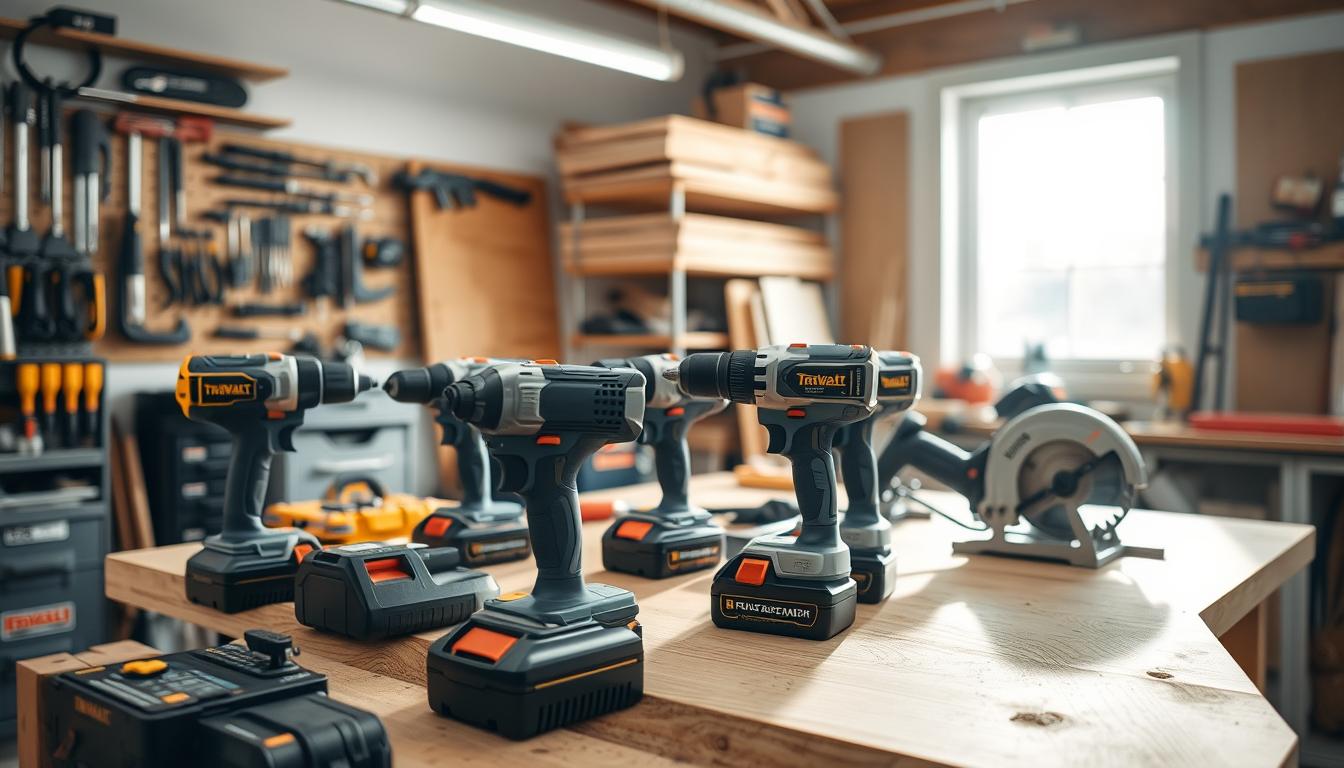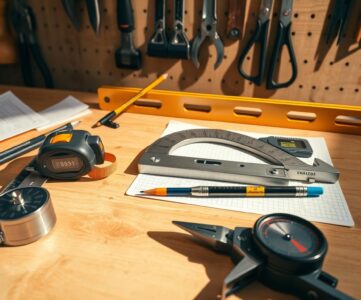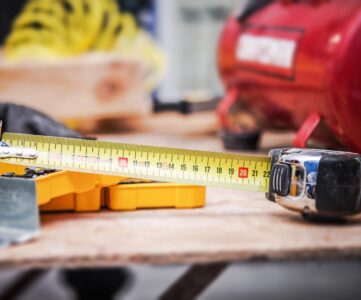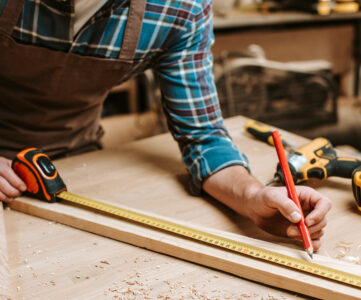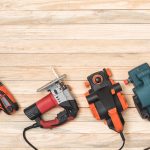Choosing between cordless tools and corded power tools is key for your workshop. Each has its own pros and cons. Knowing these helps you work more efficiently. Cordless tools are flexible and convenient, while corded tools offer steady power.
The power tool market is moving towards cordless tools. Many people prefer their freedom and ease. Yet, corded tools are still great for heavy tasks needing constant power. By comparing both, you can pick what’s best for you.
Key Takeaways
- Choose between cordless tools and corded power tools based on your workshop needs
- Cordless tools offer greater flexibility and convenience
- Corded power tools provide consistent and reliable power
- Consider the type of projects you’ll be working on and the level of power required
- Assess your workshop layout and determine which type of tool will work best for you
- Research different brands and models to find the best fit for your budget and needs
- Consider the long-term costs and benefits of each option, including maintenance and replacement costs
Understanding the Evolution of Workshop Power Tools
The history of workshop power tools is filled with innovation. It started with early corded tools and now we have battery powered tools. These changes have made tools more efficient and portable, changing how we work.
When comparing tools, it’s key to look at their history and current trends. Corded tools were once the standard but have been replaced by cordless ones. This change came from better batteries and tool designs, making cordless tools a great choice for many tasks.
The Traditional Reign of Corded Tools
Corded tools were the norm for decades, offering reliable power. But, they were limited by their cords, making them less mobile.
The Rise of Cordless Technology
Cordless technology changed the game for workshop power tools. Better batteries and motors made cordless tools as good as corded ones.
Current Market Trends
Now, battery powered tools lead the market. Many choose them for their convenience and flexibility. When comparing tools, look at power, runtime, and durability to pick the best one for the job.
| Tool Type | Power Source | Runtime | Durability |
|---|---|---|---|
| Cordless Drill | Battery | Up to 5 hours | High |
| Cordless Saw | Battery | Up to 3 hours | Medium |
| Cordless Sander | Battery | Up to 2 hours | Low |
Knowing the history and current trends of workshop power tools helps us make better choices. It’s important to compare tools and pick the right battery powered tools for our needs.
The Power Battle: Comparing Performance and Capability
When we talk about power source comparison, cordless and corded tools have their own strengths. Cordless tools have made big strides in power and efficiency. They now match the performance of corded tools in many tasks. This makes the choice between cordless and corded tools more about what you need for your project.
The type of project is a big factor in power source comparison. Cordless tools are great for moving around, like on construction sites. Corded tools are better for tasks needing lots of power, like heavy drilling or sawing. Here are some things to think about when comparing power sources:
- Power output: Cordless tools have gotten a lot better, but corded tools still have more power.
- Efficiency: Cordless tools are more efficient, losing less energy as heat.
- Convenience: Cordless tools are more mobile and easy to use, without cords.
When it comes to specific tools, the comparison changes. Cordless drills and drivers are popular for their ease and flexibility. But, many pros still choose corded saws and sanders for their steady power and reliability. Here’s a table showing some key differences in power source comparison for various tools:
| Tool | Cordless | Corded |
|---|---|---|
| Drill/Driver | High torque, convenient | Consistent power, lower cost |
| Saw | Portable, easy to maneuver | Higher power, more precise cuts |
| Sander | Lightweight, easy to use | More aggressive sanding, better for large projects |
Battery Life and Power Management in Cordless Tools
When using battery powered tools, battery life and power management are key. Knowing how to extend battery life and picking the right charger boosts tool mobility and workshop productivity.
Understanding amp hours and voltage is crucial. It helps pick the right battery for your tools and tasks. Different battery types and technologies offer various benefits and drawbacks. For example, lithium-ion batteries are favored for their high energy and long life.
Understanding Battery Specifications
- Amp Hours (Ah): Measures the battery’s capacity to deliver current over time.
- Voltage: Determines the battery’s power output and compatibility with tools.
- Cycle Life: The number of charge and discharge cycles a battery can handle before its capacity starts to degrade.
Good charging systems and options are vital for battery health and tool mobility. Fast charging cuts down on wait time, making your workshop more efficient. Some chargers also have features like battery checks and maintenance modes to improve battery performance.
Maximizing Battery Life
To maximize battery powered tools and tool mobility, follow best care and maintenance practices. Avoid deep discharges, keep batteries cool and dry, and update tool firmware for the latest battery tech.
| Battery Type | Amp Hours | Voltage | Cycle Life |
|---|---|---|---|
| Lithium-ion | 2.0 Ah | 18V | 300 cycles |
| Nickel-Cadmium | 1.5 Ah | 12V | 200 cycles |
Cost Considerations: Initial Investment vs. Long-term Value
Setting up a workshop involves thinking about the cost. The tools you buy can be expensive at first. But, they offer great value over time.
A workshop setup with cordless tools might cost more upfront. Yet, it brings flexibility and convenience later on.
Comparing tools is key to finding the best deal. Look at the cost of batteries, maintenance, and extra features. This way, you can choose wisely and save money.
When comparing costs, consider these points:
- The initial purchase price
- The cost of replacement batteries or maintenance
- The expected lifespan of the tool
- The cost of any additional features or accessories
By weighing these factors and comparing tools, you can find the best value. This will help you achieve your workshop goals.
Mobility and Workspace Freedom
Cordless tools bring a new level of flexibility to job sites and workshops. Without cords, workers can move freely, doing their jobs without cable limits. This is super helpful in big or complex projects where they need to cover a lot of ground.
In workshops, cordless tools help make the space better. They remove the need for cords, allowing for more open areas. This makes it safer and easier to work, boosting productivity and keeping the space tidy.
Job Site Flexibility
Cordless tools give workers the freedom to move around job sites easily. This is key in places like construction, where workers often work high up or in tight spots. With cordless tools, they can focus on their work, not finding a power outlet.
Workshop Layout Optimization
A well-organized workshop is key to being efficient and productive. Using cordless tools helps create a smooth and tidy work area. This includes setting up specific spots for tool storage and charging, making it easier to find what you need.
Transportation Considerations
Cordless tools are easier to carry and store than corded ones. They don’t have cords, so workers can easily take them to different sites or store them neatly. This is great for those who travel to many sites in a day.
- Improved job site flexibility
- Enhanced workshop setup and organization
- Increased tool mobility and convenience
Using cordless tools brings many benefits, from better job site flexibility to improved workshop setup. As more people use cordless tools, the importance of mobility and setup in power tools will only grow.
Tool Durability and Maintenance Requirements
When choosing between cordless tools and corded power tools, think about durability and upkeep. The life of your tools greatly affects your workshop’s efficiency and costs. Cordless tools are handy and easy to move, but their battery life and charging needs can impact their longevity. Corded power tools, on the other hand, are often more robust and dependable, but they require more care because of their cords and motors.
For cordless tools, taking care of the battery is key. Avoid extreme temperatures, keep batteries away from metal, and store them in a cool, dry spot. With corded power tools, it’s important to lubricate moving parts and check cords and plugs regularly. These steps help prevent damage and ensure your tools work safely and efficiently.
Cordless tools can face issues like battery drain, motor failure, and charging problems. Corded power tools might deal with cord damage, motor burnout, and electrical issues. Knowing these common problems helps you act early to keep your tools running well.
- Regularly inspect and maintain your tools to prevent damage and ensure safe operation
- Follow the manufacturer’s guidelines for battery care and maintenance
- Store your tools in a cool, dry place to prevent damage and extend their lifespan
Understanding the durability and upkeep needs of cordless tools and corded power tools helps you choose wisely for your workshop. This approach boosts your productivity, cuts down on downtime, and ensures you get the best from your tools.
Workshop Setup Considerations for Both Power Sources
Setting up a workshop requires thinking about your power source. A good setup boosts efficiency and productivity, no matter if you use cordless or corded tools. It’s important to weigh the pros and cons of each power source.
Planning your power station is key. Arrange workbenches, tool stations, and outlets to avoid clutter. Think about how often you use each tool to make your workflow smoother and less tiring.
Storage Solutions
Keeping your workshop tidy is crucial. Use shelving, cabinets, and drawers for big items, and toolboxes for small ones. A good storage system saves time and boosts productivity. Choosing the right storage depends on your power source comparison.
Some important things to consider include:
- Check each tool’s power needs and plan your setup
- Use the space wisely to make your layout efficient
- Choose a storage system that keeps everything organized and easy to find
By planning your workshop well, you can make it both useful and comfortable. Think about your tools and work style to create the perfect space. A detailed power source comparison and smart storage choices will help you achieve a productive workshop.
| Workshop Setup Considerations | Benefits |
|---|---|
| Power source comparison | Increased efficiency and productivity |
| Power station planning | Reduced clutter and improved accessibility |
| Storage solutions | Improved organization and reduced wasted time |
Professional vs. DIY Usage Patterns
Professionals and DIY folks have different needs when it comes to tools. A detailed comparison can guide them in making the right choice. For pros, the tool choice depends on the project’s intensity and type. Battery tools are best for heavy tasks needing lots of power and mobility.
DIY folks, on the other hand, might value ease and cost over power. They often choose cordless tools for their lightness and ease of use. These are great for smaller home projects. Both pros and DIY folks should consider the project type. For example, a contractor might need a strong cordless drill for big sites, while a DIYer might prefer a smaller tool for a treehouse.
Work Intensity Considerations
Work intensity is key in choosing a tool. Pros on tough projects might prefer corded tools for their power. Those working in tight spots or at heights might choose battery tools. DIY folks often look for tools that are easy to use and don’t need much upkeep.
Project Type Analysis
Project type is crucial in picking the right tool. Different projects need different tools. For instance, a carpenter might need a precise cordless saw for furniture, while a DIYer might prefer a versatile and affordable drill for a deck.
The choice between corded and cordless tools depends on several factors. These include work intensity, project type, and personal preference. By considering these and comparing tools, both pros and DIY folks can make the best choice for their needs.
Environmental Impact and Energy Efficiency
When we talk about cordless tools and corded power tools, we must think about the environment. How we make, use, and throw away these tools matters a lot.
Important things to look at include how much energy they use, the waste they create, and if they’re made from sustainable materials. Cordless tools often use less energy because they have rechargeable batteries. They don’t need to be plugged in all the time.
Here are some ways to lessen the harm to the environment from cordless tools and corded power tools:
- Choose tools with energy-efficient motors and batteries
- Use sustainable materials for tool construction and packaging
- Properly dispose of tools and batteries at the end of their life cycle
By thinking about the environmental impact and energy use of cordless tools and corded power tools, we can make better choices. This helps us leave a smaller mark on the planet.
Future-Proofing Your Tool Investment
The world of power tools is always changing. It’s key to think about the future when buying tools. Tool mobility is now more important than ever. We need tools that are strong, easy to carry, and work well in different places.
When comparing power sources, think about the long-term. Cordless tools are great for moving around but need more charging. Corded tools give steady power but are tied down by their cords.
Technology Trends
New tech in power tools includes better battery control and more efficient motors. These changes will keep shaping the industry. It’s important to keep up with these updates.
Compatibility Considerations
It’s also vital to think about how your tools will work with future systems. Make sure batteries, chargers, and accessories will fit with your tools.
Upgrade Pathways
Lastly, think about how you can upgrade your tools. You might need new batteries or motors, or even switch to newer models. Planning for upgrades helps your tools stay useful as new tech comes out.
- Advanced battery management systems
- More efficient motor designs
- Compatibility with existing and future systems
- Upgrade pathways for tools and accessories
By keeping these points in mind and staying up-to-date, you can make your tool investment last. Your tools will stay useful and effective for many years.
Conclusion: Making the Right Choice for Your Specific Needs
Choosing between cordless tools and corded power tools depends on your workshop needs. It also depends on your project requirements and personal preferences. There’s no single best choice for everyone.
Think about what you need when deciding. Consider how tools compare, their performance, battery life, cost, and how mobile you need to be. This helps make sure your workshop has the right tools for any job.
Whether you pick cordless or corded tools, keep up with new technology. Also, think about how well your tools will work together in the future. With the right mix of power, portability, and cost, your workshop will be ready for anything.
